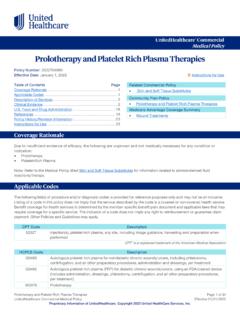Transcription of The Anti- Inflammatory and Elimination Diet for Adults ...
1 1 Saint Louis University School of Medicine Department of Obstetrics, Gynecology, and Women s Health Center for Endometriosis Patrick Yeung, Jr. MD Rose Catanzaro MS, RDN, LDN 1031 Bellevue Ave, Suite 400 St. Louis, MO 63117 314-977-7455 The Anti- Inflammatory and Elimination Diet for Adults Living with Endometriosis 2 Table of Contents Overview of Endometriosis ..3-4 What should your diet be composed of? ..5 Breakdown of Food Organic or not? ..9 Hidden hormones in Your Food ..10 Which Fats are the Most Anti- Inflammatory ?
2 11 Omegas by the Omega-3 Supplementation ..13 Elimination Diet and Endometriosis ..14 Implementing the Endo Elimination Diet ..15-16 Dairy Foods ..17 Gluten Foods ..18-21 Added Sugars ..22 The Basics of a Healthy Well Balanced Diet ..25 References ..26-27 Food Intake Log and Symptom Diary ..28 3 Overview of Endometriosis Endometriosis is a painful, chronic disease where tissue that normally lines the uterus grows outside of the uterus. Such areas of growth include the abdomen on the ovaries and fallopian tube as well as the bladder, bowel, vagina, cervix, and the area between the vagina and rectum.
3 The misplaced tissue builds up, breaks down, and sheds like the tissue that lines the uterus during menstrual cycles. However, the misplaced tissue has no way of exiting the body which results in internal bleeding, inflammation, bowel problems, infertility, scar tissue formation, and adhesions. Symptoms Infertility Fatigue Painful urination before periods Painful bowel movements during periods Pain with sex Pain before and during periods due to severe cramping, heavy menstrual flow, and periods lasting > 7 days Diarrhea Constipation Nausea Prevalence About 1 in 10 women in the have endometriosis.
4 About 176 million women worldwide have endometriosis. Symptoms usually occur during reproductive age (12-60 years old) but most women are often undiagnosed. Source: 4 Overview of Endometriosis Causes There is no identified cause for endometriosis. Theories related to genetics suggest that it may be carried in genes so some families may be more predisposed to it than others. Another theory has found it to be present at fetal development and activated during puberty. A retrograde menstruation theory suggests that menstrual tissue can back up into the fallopian tube, implant in the abdomen, and grow which can lead to the development of endometriosis.
5 Lastly, there has been a link between the body s Inflammatory response and endometriosis but the mechanism behind this theory is not well understood. Treatment To confirm diagnosis, a laparoscopy is performed which will show the location, size, and extent of the growths. The gold standard for treatment is laparoscopic excision surgery to remove the growths. However, there is no cure for endometriosis. Source: 5 What should your diet be composed of? Vegetables 4-5 svg/day Fruits 1-2 svg/day Healthy cold-pressed oils (Extra virgin, canola flaxseed, nut-based oils), 2-4 svg/day Fish, seafood 3-5 svg/week Lean meat, poultry, eggs 3-5 svg/week Beans, legumes 2-4 svg/week Red meat 1-2 svg/week Nuts and seeds 1-2 svg/ day Whole grains (Gluten-free if necessary) 3-5 svg/day Low-fat Dairy (Dairy-free if necessary) 3 svg/day Alcohol, caffeine & sweets 1-2 svg/week 6 Vegetables: How much?
6 4-5 servings per day minimum (one serving = 2 cups salad greens, cup vegetables cooked) Healthy Sources: Dark leafy greens (spinach, collard greens, kale, Swiss card), cruciferous vegetables (broccoli, cabbage, Brussels sprouts, bok choy, cauliflower), carrots, beets, onion, peas, squashes, washed raw salad greens Why? Vegetables are rich in flavonoids and carotenoids with antioxidant and Anti- Inflammatory properties. Aim for a plate that s colorful in vegetables to get a wide variety of vitamins, including A, E, and C as studies have shown these vitamins to be lower in endometriosis patients.
7 Fruits: How much? 1-2 servings per day (one serving = 1 medium size piece of fruit, cup chopped fruit, cup dried fruit) Healthy Sources: Raspberries, blueberries, strawberries, peaches, nectarines, oranges, pink grapefruit, red grapes, plums, pomegranates, blackberries, cherries, apples, and pears all have lower glycemic index. Why? Fruits are rich in flavonoids and carotenoids with antioxidant and Anti- Inflammatory properties. Aim for variety in color to get a wide variety of nutrients, including A, E, and C. When possible, choose organic for reduced pesticide residue that have been associated with hormone imbalances.
8 Fish and Seafood How much? 3-5 servings per week (one serving = 4 oz. of fish or seafood) Healthy Sources: Wild Alaskan salmon, herring, sardines, and black cod Why? Fish is rich in Omega-3s which are Anti- Inflammatory . Choose higher fat, deep-sea fish as they have greater intakes of Omega-3s. Lean Meat, Poultry, Eggs How much? 3-5 servings per week (one serving = 3 oz. of poultry or skinless meat) Healthy Sources: High quality skinless poultry, turkey, grass-fed lean meats, free-range eggs Why? Lean meats are lower in saturated fat to better control cholesterol levels.
9 7 Beans and Legumes How much? 2-4 servings per week (one serving = cup cooked beans or legumes) Healthy Sources: Black beans, chickpeas, black-eyed peas, and lentils Why? Beans are rich in folic acid, magnesium, and potassium and soluble fiber. They are a low-glycemic-load foods to stabilize blood sugars. Red Meat How much? 1-2 servings per week (one serving = 3 oz. of cooked meat) Sources: Beef, steak, pork, veal Why? Limit these types of foods as red meats are shown to be pro- Inflammatory and cause hormone imbalances.
10 Choose grass-fed or organic meats. Cold-Pressed Vegetable Oils How much? 2-4 servings a day (one serving= 1 teaspoon of oil) Healthy Sources: Extra virgin olive oil, vegetable oil, canola oil, flaxseed oils, nut-based oils Why? Oils are high in Omega-3s and antioxidants which are Anti- Inflammatory . They are also rich in monounsaturated fats that raise good cholesterol (HDLs) and lower bad cholesterol (LDLs). Expelled cold-pressed oil is best since it is not chemically treated and heated at lower temperatures to extract the oil.






